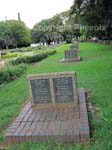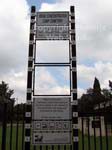Irene Concentration Camp and Garden of Remembrance
Irene Concentration Camp and Garden of Remembrance.
Overview of the Irene Concentration Camp
Opened on 2 November 1900, the Irene Concentration Camp was built with the intention that it would be one of the camps that would house Boer woman and children, driven from their land by the British “scorched earth” policy. This policy dictated the destruction of the farms and lands of Boer soldiers.
The conditions in the camp, located on the chilly southern side of the town, were extremely primitive. Life was exceptionally hard, and very little notice were taken by the authorities of the deaths that their lack of interest in the inmates caused.
The population increased rapidly in these poor conditions. In April 1901, it was recorded that the Irene Concentration Camp accommodated approximately 3 703 inmates, of which 317 were sick and 49 had perished. By the end of 1901 more than 800 people had died.
The Irene Concentration camp received much more attention than any other concentration camp, for a number of reasons. Located so close to Pretoria, it was under the eye of senior camp authorities. A group of Boer women from Pretoria who started a nursing corps in April 1901, gave the Irene Concentration camp additional notoriety.
The Irene Concentration Camp later extended, creating a second camp, known as Nylstroom. By the end of 1902 more than 5 400 people were held captive in the two camps. Although peace was declared in May 1902, the Irene Concentration Camp was allegedly closed during 1903, since no reports for the camp appears after 1903.
Today, the Irene Concentration Camp is a national heritage site, under the protection of the SA Heritage Resource Agency. The cemetery has more than 2 000 people buried there, although the cemetery’s name list only lists 1 149 people.
During excavations, a name plate with the number 2156 was found. However, only 850 heaps of soil, indicating graves, were uncovered. The original gravestones, generally hand-engraved on slate, were removed and placed under cover to prevent further weather damage. Later, the graves were formalized with stone plaques engraved with the names of people who had died during their horrible time in the Irene Concentration Camp.
You can read more on the history of the Irene Concentration camp here.
Review of the Irene Concentration Camp
In all honesty, I did not even want to write this review. This was one of the saddest places I have visited in a long time. And to find memorial plates with my family surname printed on it was even sadder, having to think what conditions these people had to endure.
Printed on paper slips in the windows of the entrance building, are the reasons why some of the people died.
Diseases that normally would have been under control, reigned in terror. So many unnecessary deaths. I am extremely thankful for not having to live in those times.
View photographs of all the headstones in the Irene Concentration Camp














